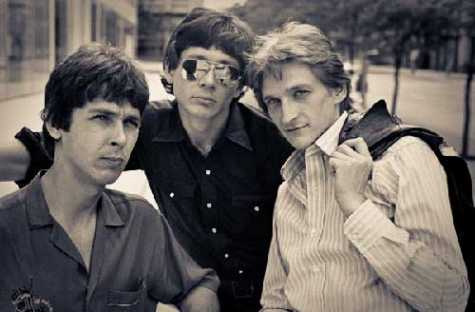In the song “Takin' Care of Business” by Bachman-Turner Overdrive, the band offers their prescribed formula for rock star success: "Get a second-hand guitar, chances are you'll go far if you get in with the right bunch of fellows."
Things didn't go exactly that way for Jim Keller, collision lifer and owner of 1Collision Network---but they nearly did.
It all began when Keller saw the Beatles perform on “The Ed Sullivan Show” when he was 10 years old.
"I knew right then that I wanted to be a musician and specifically a drummer," he said. "I was immediately drawn to Ringo and shortly after that, I began drumming along to songs on the radio on an improvised drum set that consisted of two upside-down wastebaskets and a pair of rulers. I cut out a picture of a real drum set from a JCPenney catalog and taped it to the bathroom mirror, and I guess my parents got the hint because I got an $89.95 three-piece drum set for Christmas."
Keller learned how to monetize his love for the drums and entered the collision repair industry at the same time.
"At 12, I was making $25 cash on Saturday nights performing at weddings with a polka band," he said. "I was also working at my friend’s father's body shop, sanding cars, picking up supplies on my bike and driving customers home, even though I obviously didn't have my license yet. I made $40--$100 weekly there, which made me the richest kid in town."
After taking some formal lessons, Keller started playing percussion for his high school's band, including marching band, jazz ensemble and orchestra.
To become a better drummer, Keller practiced his drums for 90 minutes in his basement every day before joining a few local rock bands and playing cover songs by Jimi Hendrix and Savoy Brown.
"We played a lot of blues-influenced music and acid rock," he said. "A few years later, a friend of mine encouraged me to audition for a band called In a Hot Coma, and I got the gig."
Good things happened quickly for In a Hot Coma. The band was soon asked to open up for Cheap Trick right before their debut album on Epic was released, Keller said.
After several years, Keller left In a Hot Coma and played in local bands, including a short stint playing with Howie Epstein, who later became the longtime bass player for Tom Petty and the Heartbreakers, as well as The Shivvers, a popular Milwaukee power pop band. He then joined a Rockford-based pop group called The Names until he joined The Baxters with Martin Krohne on guitar and Greg Scott on bass. After capturing second place at a State Fair Battle Of The Bands competition in West Allis, WI, The Baxters made their debut at a popular punk club, Zak’s, Milwaukee's first punk club, on New Year's Eve.
For the next two years, the trio wrote original songs and played shows in cities such as Rockford, Chicago, Milwaukee and Madison. With 200 original songs in their repertoire, The Baxters came up with two tunes that got some attention in 1980: "What Ya Gonna Do" and "Don't Run Away," both of which can be heard on YouTube.
The band recorded the songs at Star Studios on National Avenue but couldn't put together enough money to release a record. Seventeen years later, "Don't Run Away" appeared on a CD featuring iconic Milwaukee band Great Lost Brew Wave, while "What Ya Gonna Do" made it onto a 2001 CD set called History in 3 Chords.
In addition to Ringo Starr, Keller said, several other legendary drummers have influenced him over the years, such as John Bonham (Led Zeppelin); Keith Moon (The Who) and Bun E. Carlos (Cheap Trick).
Keller got to know Carlos when his band opened for Cheap Trick and helped him in one unique way.
"I would use the same drumsticks over and over and beat them up because they're not inexpensive," he said. "One day, I came offstage and Bun E. saw that my sticks were all nicked up, so he got one of his roadies to give me a large box full of his used sticks. I used them for the next two years and will never forget Bun E. for that!"
The Baxters broke up at the end of 1981. Keller opened a body shop and put his drumsticks down, while his two bandmates formed a top 40 band called Tommy Gunn.
"It was the right time for me to give up my rock star dreams and pursue a career, as well as get married and have some kids," he said.
In 1985, Keller purchased his second shop and subsequently merged them with a large MSO and became a partner in a business that eventually operated 27 shops. He then got involved with Crash 1 and in 2013, it became 1Collision, which was headquartered in Milwaukee, WI.
1Collision has grown from eight shops to 43, and Keller is signing up new ones all the time, he said.
"We've proven that we can help our network shops by maintaining excellent relationships with our insurance company partners, processing claims quickly, using the latest claim processing and OEM repair technologies and processes by the implementation of our SMART Performance System. We also enable them to succeed by utilizing our marketing, business strategy, HR & recruiting, equipment and material purchasing programs, financial management programs, and utilizing O.E. parts. We also offer consumers a written, limited lifetime warranty," he said.
Although he is now a successful businessman who is well-known in the collision repair industry, Keller looks back fondly at his years as a rocker and still loves playing music, he said.
"I play the guitar and the piano to relax and unwind, but not the drums anymore,” he said. “The Baxters never hit big, but it was a great experience, and I'm happy to know that people still listen to our songs almost 40 years later."











Ed Attanasio